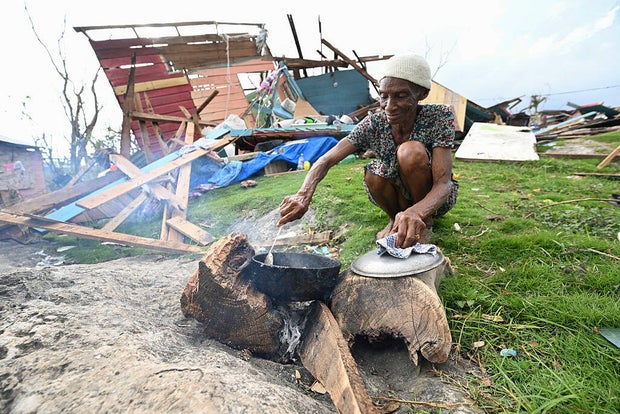Rescuers and aid workers fanned out across Jamaica on Saturday to distribute food and water and reach communities still isolated for four days. after Hurricane Melissa hit the island.
One of the strongest hurricanes in the Atlantic To make landfall, Melissa is blamed for at least 19 deaths in Jamaica, 31 deaths in neighboring Haiti and at least one death in the Dominican Republic. Melissa struck southwestern Jamaica on Tuesday as a Category 5 hurricane with winds of 185 mph.
RICARDO MAKIN/AFP via Getty Images
Health Minister Christopher Tufton acknowledged the death toll in Jamaica was likely higher as many sites remained difficult to reach, but said it would be unwise to speculate.
Less than half the island has communications, and the hurricane knocked out nearly 400 water systems.
US Army deployed Three CH-47 Chinook helicopters departed for Jamaica on Friday to provide humanitarian aid and disaster relief, with five more helicopters en route.
Jamaican officials on Saturday also announced plans to set up several field hospitals after several hospitals in western Jamaica were hit particularly hard by the hurricane, Agence-France Presse reported.
“The facility will be fully equipped, including an operating room and other critical diagnostic equipment, as well as some team members to support the local team,” Tufton said at a briefing on Saturday, AFP reported, adding that officials expect the hospital to be operational in the coming week.
There were desperate scenes in Montego Bay as residents lined up for food, water and money. Many US tourists are still trying to get home. The Gray Bull Rescue Foundation, a non-profit organization based in Florida, has found a way to return 341 American citizens from two hard-hit resorts in Montego Bay.
Relief is currently being delivered to hurricane-ravaged St. Elizabeth and Westmoreland, much of which has been cut off by fallen concrete pillars and trees strewn across roads.
But in some parts, people were forced to dip buckets into rivers to collect muddy water for daily use, while others drank coconut water and fried breadfruit.
In Westmoreland, the shoreline was littered with twisted metal sheets, splintered wooden frames of houses and fragments of furniture.
Social Welfare Secretary Pearnel Charles Jr. was among several convoys of emergency services dispatched to deliver prepared food, water, tarpaulins, blankets, medicine and other emergency supplies.
“The priority now is to get help to those who need it,” Charles Jr. said during a brief stop en route to Black River for the first time with the long-awaited humanitarian aid. Prime Minister Andrew Holness declared Black River the epicenter of the epidemic and said the city would have to be rebuilt.
The Jamaica Defense Force has set up a disaster relief satellite site at the Luana Community Center near Black River, from where medical aid packages are being delivered to storm-affected residents.
Many of them had been without vital supplies since Tuesday and quickly gathered around a JDF truck as rumors spread that aid was being handed out under the scorching midday sun.
“Everyone is homeless now,” Rosemary Gale said. “Thank you, thank you. I can’t tell you enough,” she said as she accepted a parcel of rice, beans, sardines, milk powder, cooking oil and other essentials.
RICARDO MAKIN/AFP via Getty Images
Melissa left behind devastationsevering power lines and destroying buildings, disrupting the distribution of food and water, and destroying crop fields.
Satellite photos showed the fishing village of White House in southwest Jamaica and the nearby town of Black River before and after Melissa crashed into the island. Each couple captured a once-bustling city reduced to dirt and ruins.
Some people walked for miles to find essential supplies and visit loved ones as more than 60% of the island remained without power. Helicopters are dropping food into isolated communities.
“People are in shock and waiting for help,” said World Vision national director for domestic humanitarian and emergency affairs Mike Bassett, who traveled to the town of St. Croix in St. Elizabeth on Friday.
“The biggest needs are clean water, tarps in case of roof damage, canned proteins, hygiene products and cleaning supplies,” he said.
On Saturday, the UN World Food Program received 2,000 boxes of emergency food aid sent from Barbados for distribution to shelters and the hardest hit communities in the St. Elizabeth region.
“They will help meet the needs of 6,000 people for one week,” said WFP public affairs officer Alexis Masciarelli.
Tufton also warned of the risk of increased mosquitoes, waterborne diseases and food poisoning. “Please throw away the spoiled food,” he said.
The US Regional Disaster Response Team has arrived on scene after it was activated by Secretary of State Marco Rubio earlier this week, the US Embassy in Jamaica said.
“The United States stands with Jamaica as it responds to the impact of the hurricane and remains ready to quickly deliver emergency relief supplies,” the statement said.
RICARDO MAKIN/AFP via Getty Images
Jamaican Minister of Water and Environment Matthew Samuda logged into social media platform X in a desperate attempt to find tarpaulin after Melissa ripped off dozens of roofs from houses in western Jamaica. X users joined us to help by pointing out where they saw supplies.
Falmouth, a popular fishing spot on Jamaica's north coast, suffered extensive damage, including flooding and collapsed buildings, Holness said on Saturday.
“Our immediate priority is to restore power and telecommunications, and ensure that essential services are stabilized, especially at Falmouth Hospital,” he said on X, adding that Jamaica will recover “stronger and wiser.”
Following the devastation, the Caribbean Catastrophe Risk Insurance Fund said it would pay Jamaica a record $70.8 million.
This mechanism allows countries to pool their individual risks to provide affordable disaster insurance. The payment will be made within 14 days, the group said on Friday.
Finance Minister Fayval Williams said on Thursday that the CCRIF insurance policy was only part of the government's financial plan to respond to natural disasters. She pointed to the emergency fund, the national disaster reserve and catastrophe bonds.
Government officials said damage assessments were still ongoing.










